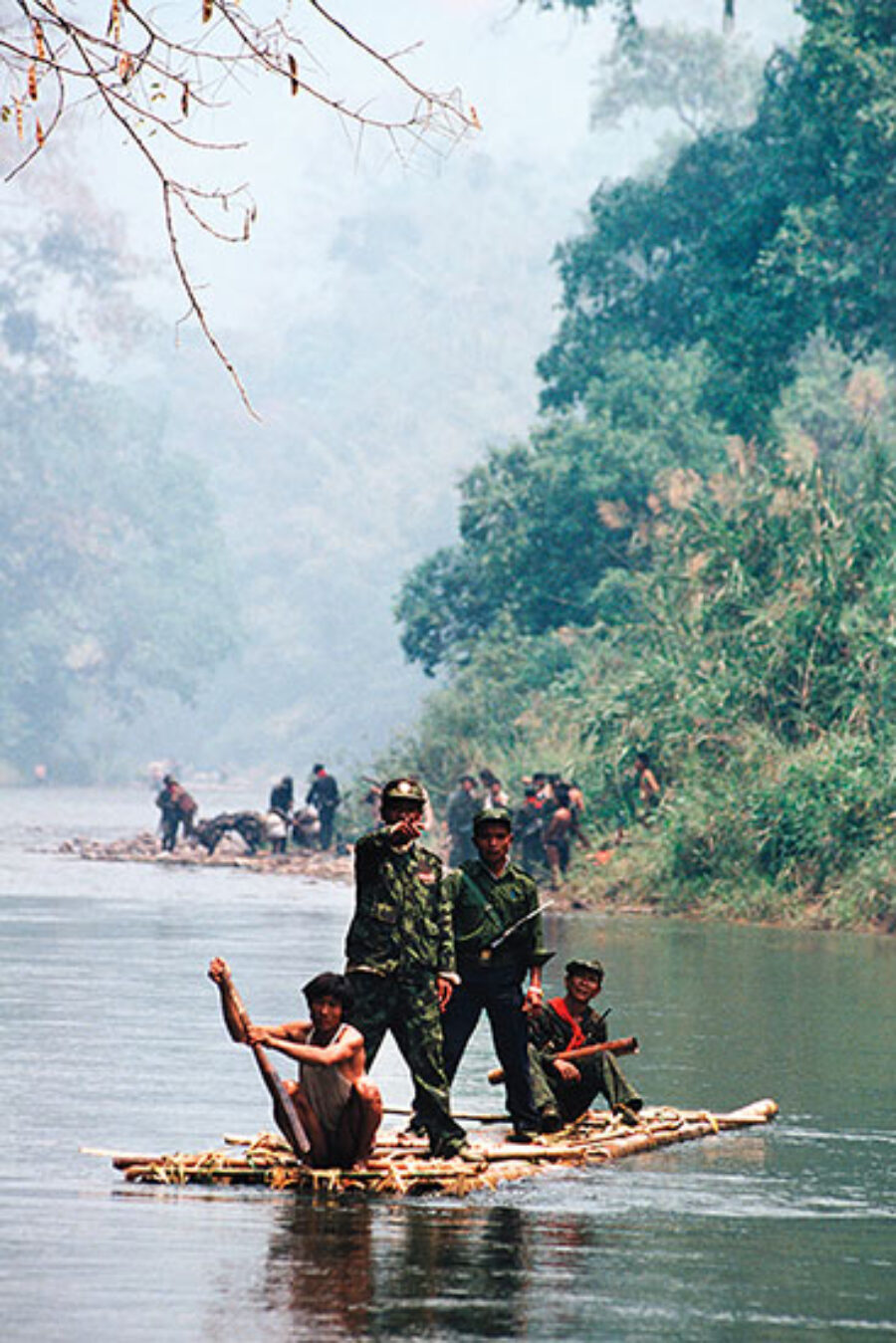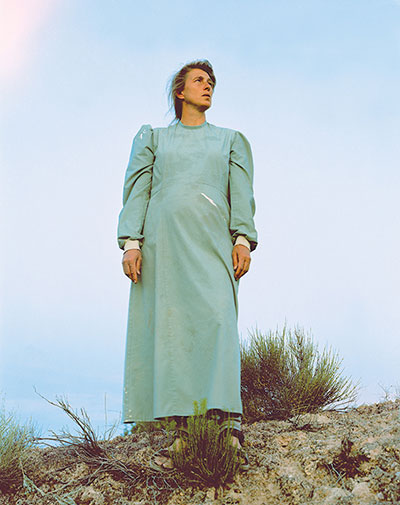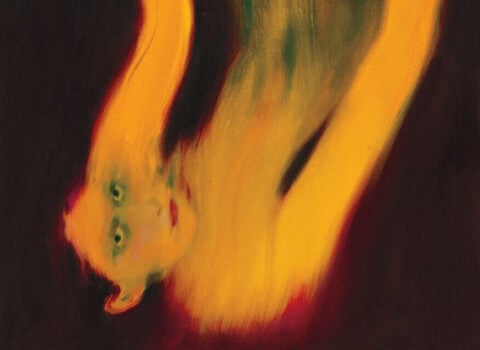
Saw Lu on an expedition from Thailand
to the Wa State, January 1993
© Thierry Falise/LightRocket/Getty Images
New Books
The Wa State is an autonomous zone nestled in the highlands of Myanmar bordering China and Thailand. You won’t find it on United Nations maps, but it’s about the size of Belgium, with its own army, schools, and tax collectors. The Wa’s self-sufficiency derives from one of their top exports, methamphetamine, which they produce with such knee-weakening efficiency that, frankly, they make me want to try some. Their ya-ba, or “insanity pills,” sell for anything from one to three bucks a pop; they’re dyed a cheery Benadryl pink, infused with an imitation vanilla scent, and stamped with wy, a logo that’s “as recognizable to Asian drug users as Nike’s swoosh,” Patrick Winn writes in Narcotopia: In Search of the Asian Drug Cartel That Survived the CIA (PublicAffairs, $30). “Per annual units sold,” he adds, “ya-ba pills outperform Big Macs and Starbucks coffee orders worldwide.”
Winn, an American journalist based in Bangkok, believes the Wa are misconstrued as a barbaric crime syndicate. (This is when they’re construed at all; most Westerners simply don’t know they exist.) Better to think of them, he offers, as “an indigenous people who’ve tapped the power of narcotics to create a nation where there was none before.” The DEA aspires to dismantle the Wa State, and Americans have rarely trodden upon its soil, but Winn decided to give it a go. What he discovered was a long history of U.S. meddling that amounts to one of the foolhardiest chapters in the war on drugs—a conflict hardly wanting for foolhardiness.
Arranging a candid sit-down with a Wa kingpin proved impossible, but Winn stumbled on an almost pluperfect source in Saw Lu, a Wa man who’d served variously as a spy for the Burmese junta, an officer for the United Wa State Army (UWSA), and a DEA informant so invaluable that the agency called him “Superstar.” A Maoist army had pushed his family from their homeland when he was still a boy, so he hated communists, and better still, a missionary had made a Baptist of him. For most of his life he’d been committed to the idea that the Wa could be not only a free people, but a drug-free people (free of most drugs, anyway; he smoked a steady stream of tobacco from a three-foot bong). Saw Lu idealized the United States as a Christian nation. Where many informants wanted only money, he “envisioned the United States building schools, hospitals, and paved roads in the Wa peaks,” Winn writes, “to lay the foundations of a modern state.”
Before the Wa made meth, they made heroin—poppies were one of the few viable crops at high elevation—much of which made its way into American veins. Saw Lu fed the DEA reliable facts about Wa throughput and trafficking routes. He continued to do this even after clumsy DEA handling led to his arrest by the Burmese junta, which tortured him for days on end. Among other tactics, they “clipped electrodes to his penis and wired it to a truck battery.”
The DEA’s ability to produce accurate intelligence aroused the envy of the CIA, who’d long attempted to cultivate the Wa people as anticommunist assets. Asians could “be plucked by the Communists like ripe fruit,” one CIA report read; another noted that the Wa “are unanimous in their desire to have the white man assist them and even rule them.” Not true, it turned out. The Wa, notorious headhunters, liked to arrange long rows of skulls on pikes, and would sometimes kill outsiders on sight. Winn describes “cloth-covered globes of opium, each tied up in twine like a butcher shop ham,” and the smell of a decapitated head—“a ferrous stink, like rusty nails.” Saw Lu was the closest any U.S. agent would get to a friendly face. That he was cooperating with the DEA—glorified beat cops who cared more about photographing piles of heroin than halting the Red Menace—really riled up the spooks.
The clear solution was sabotage. In the summer of 1993, the DEA moved to reward Saw Lu for his years of service by negotiating a landmark deal with the UWSA. The two groups arranged a splashy summit: They’d meet on a mountaintop, shake hands, light some poppy fields on fire; the Wa would agree to leave the drug trade behind for good, and the Americans would pump funds into the region. But the CIA gave Saw Lu the wrong date. He gathered his men and awaited the sound of helicopters that never came. Incensed, the Wa State consigned him to a hovel. By the time he died, in 2021, the Wa had only consolidated their reputation as a savvy narco-tribe insulated from Western imperialism. Indeed, their turn from opium to meth owed more to prudent business decisions than to any pressure from Americans—“a confounding people,” Winn writes, “so warlike they’d fly across the world just to tussle with their own kind.”
American folly also animates Benjamin E. Park’s American Zion: A New History of Mormonism (Liveright, $35), which boasts infighting, outfighting, and moral certitude. It traces the Church of Jesus Christ of Latter-day Saints’ long and variegated efforts to contain its idiosyncrasies—both to its own satisfaction and to that of the rest of the country. “We are not a weird people,” the LDS president told 60 Minutes in 1996. A totally normal thing to say.

“Gunlock Church Interior, 1953,” by Dorothea Lange © The Dorothea Lange Collection, Oakland Museum of California. Gift of Paul S. Taylor.
But then, most major religions got their growing pains out of the way before the public eye was quite so glaring. Mormonism had to come of age amid the trappings of modernity—nosy newspapermen, tell-all memoirs, civil-rights movements—and its schisms have brought a certain glee to mainstream Christians, who often seem to resent it for being young and homegrown. Park, who was raised Mormon, frames the church as an experiment within the American experiment, one regularly thwarted by the nation’s hithering and thithering. For decades, to be Mormon was to be pursued by an angry mob; its founder, Joseph Smith, was shot dead by one. Thus, though Mormonism was “destined to be an American faith,” its leaders “insisted it could not be too American, lest it lose the singularity that proved its necessity.”
This tension was evident from its inception in 1827, when, in Palmyra, New York, the twenty-one-year-old Smith dug up some golden plates containing the text of the Book of Mormon, written in a language he called “reformed Egyptian.” The angel Moroni had told him where to look. It’s impossible to make sense of this discovery, Park argues, without understanding that Smith was not just spiritually unfulfilled but also swept up in what was then a regional treasure-hunting fad. Living in a relatively new country meant indulging your intuition that there was still cool stuff underground. Smith’s father bragged that he’d been in the “money digging” game for three decades, and, as legend goes, Smith himself had once impressed a farmer by literally finding a needle in a haystack; his detection skills were known for miles around. To wed this kind of magic and folklore to a new religion, then, was not so strange as it may seem.
“It is nearly impossible not to take a stand on miraculous accounts when writing on a faith that adamantly believes in miracles,” Park writes, but he tries. His account of the exhuming is a lesson in circumspection: “Though [Smith] and his fellow seekers had failed to find treasure in the area just a few days earlier, [he] now claimed to uncover a box that contained the plates.” Smith didn’t let his wife see them, and he sometimes dictated their revelations from behind a curtain, or while examining a magical stone inside of a hat; he stashed the plates in a decaying log, a barrel of flaxseed, and a cask of beans, and when his work was done he gave them back to Moroni.
If Mormonism has been consumed by debate about the divine provenance of these plates, it’s been even more riven by polygamy, a practice Smith initiated toward the end of his life, when he decided he needed a seventeen-year-old wife in addition to the (older) one he already had. He went to the grave with more than thirty sealings—Mormons’ tomblike term of art for plural marriage—under his belt, and though he wished for these to remain secret, his doctrine became the watchword for Mormon weirdness. Brigham Young, whose ample red hair Park describes three times, had at least fifty-five wives and nearly sixty children. Marriages to girls as young as thirteen were sometimes sanctioned; available wives could be scarce. The church formally did away with polygamy in 1890, as part of an “incremental movement toward American denominationalism,” Park writes, and though it continued more discreetly, generations of Mormon historians were dissuaded from looking into it, such that many in the faith came to believe that Smith had never practiced polygamy at all.

A photograph by Tanyth Berkeley from her book The Walking Woman © The artist
Smith had imagined his flock living in a kingdom separate from “America’s supposedly decaying ecclesiastical carcass,” Park writes; moving ever westward, from New York to Ohio to Missouri to Illinois to Utah, Mormons attempted to forge an autonomous zone not unlike that of the Wa State, with God standing in for heroin. But future LDS leaders spent much of the late-nineteenth and twentieth centuries fusing the church to the religious right—through various revelations and excommunications, they gradually, if anxiously, brought the church in line with evangelical expectations. Other denominations still hated them, but at least now everyone could unite against the Equal Rights Amendment. The most American thing about the Mormons might be their sense that every aspect of the country is at once too American and not American enough: their desire to stand apart and to belong. “Religions thrive,” Park says, “when they transform with time but still convince followers they never change.”
American Zion is a scrupulous if staid history. I wish Park had reflected more on how his own ties to the church colored his understanding. But his account of the faith’s flux successfully demystifies it. If Mormonism is weird, where is the locus of its weirdness? A popular answer lies in its hairsplitting, legalistic approach to sin. Albert Carrington, an apostle excommunicated for adultery in 1885, solemnly maintained that he did not “go the whole figure” because he hadn’t fully penetrated any of his mistresses and had pulled out; David O. McKay, the church’s leader in the Fifties, chewed rum cake with a wink, for “the Word of Wisdom forbade drinking alcohol, not eating it.” In the Sixties, Vern O. Knudsen, a Mormon physicist, argued for modest dress by convening a group of miniskirted women and demonstrating, by firing a gun, that their bare legs reflected too many sound waves in concert halls.
But every religion is weird about flesh and pleasure. The church’s history of patriarchy and racism (black people were barred from joining the priesthood between 1852 and 1978; women are still forbidden) is also hardly unusual. Maybe there’s something to be said for its commercialism—is that weird? Park notes that Smith founded the Latter-day Saints in an era when “the marketplace” had taught Americans “that innovation would be rewarded.” The late LDS leader Clayton Christensen, a business professor who coined the term “disruptive innovation,” wrote an article titled “If Harvard Business School were a religion, it could be Mormonism.” In 2012, LDS members celebrated a new mall by chanting, “Let’s go shopping!” Of course, this too is in the American grain. Pentecostalism’s prosperity gospel draws from the same well: God says you should be a damn fine entrepreneur. Get out there and dig for treasure.
Guy Davenport, the original author of this column, credited his critical acumen to a childhood spent treasure hunting. Sundays after church, his dad took him to scour fields throughout the South for arrowheads:
What lives brightest in the memory of these outings is a Thoreauvian feeling of looking at things—earth, plants, rocks, textures, animal tracks, all the secret places of the out-of-doors that seem not ever to have been looked at before, a hidden patch of moss with a Dutchman’s Breeches stoutly in its midst, aromatic stands of rabbit tobacco, beggar’s lice, lizards, the inevitable mute snake, always just leaving as you come upon him, hawks, buzzards, abandoned orchards rich in apples, peaches or plums … The search was the thing, the pleasure of looking … My sense of place, of occasion, even of doing anything at all, was shaped by those afternoons.
That’s vintage Davenport. Effortlessly, unabashedly learned; tender beneath its professorial carapace; vaguely excessive. John Jeremiah Sullivan, introducing the reissue of Davenport’s The Geography of the Imagination: Forty Essays (Godine, $22.95), writes, “He once defined ‘despair’ as the sensation that you’ve run out of ideas.” I wonder how that sensation registered to “the man who noticed that ‘in all of Balthus’ one finds no clocks.”

Yellow Garden, by Ben Sledsens. Courtesy Tim Van Laere Gallery
Geography was first published in 1981. Its essays treat everything from Edgar Allan Poe’s decorating advice (hang lots of paintings) to the profundity of Buckminster Fuller (“you can’t argue with a geodesic dome”) to William Carlos Williams’s obstetric gaze (“A poet whose lifelong business it was to bring babies into the world could never see nature as anything but counterentropic”). Davenport’s insights approach the pyrotechnical, but his prose is approachable, never pedantic. His thesis may be simply this, from the title essay: “The way we shape and use the world, indeed the way we see the world, has geographical boundaries … These boundaries can be crossed.”

“Anole Lizard,” by David Johndrow © The artist. Courtesy PDNB Gallery, Dallas
Consider him your ferry captain. Don’t doubt his bona fides. He’s an almost too-true believer in literature—“the body of knowledge locked into and releasable from poetry can replace practically any university in the Republic,” he writes—and he presumes, courteously but absurdly, that every American shares his erudition. Hugh Kenner, reviewing Geography in these pages, wrote, “There’s no getting around the way Davenport’s poets and painters, as we get to know them, come to resemble Guy Davenport.”
But that’s the American way, as we’ve seen. Remake the world in your image, squint hard when you no longer recognize it. And marvel at the folkways of outsiders, as Davenport does in “The Anthropology of Table Manners from Geophagy Onward”:
Among the Penan of the upper Baram in Sarawak you eat your friend’s snot as a sign of your esteem. There are dinner parties in Africa where the butter for your stewed calabash will be milked from your hostess’s hair. And you dare not refuse.
I don’t know if this is true, but I dare not refuse. Davenport’s criticism feels so self-contained that one swallows it with the hungry thoughtlessness of an eternal student. I turn the pages and find that I have nothing to add. Is this despair? I’ll take it.





